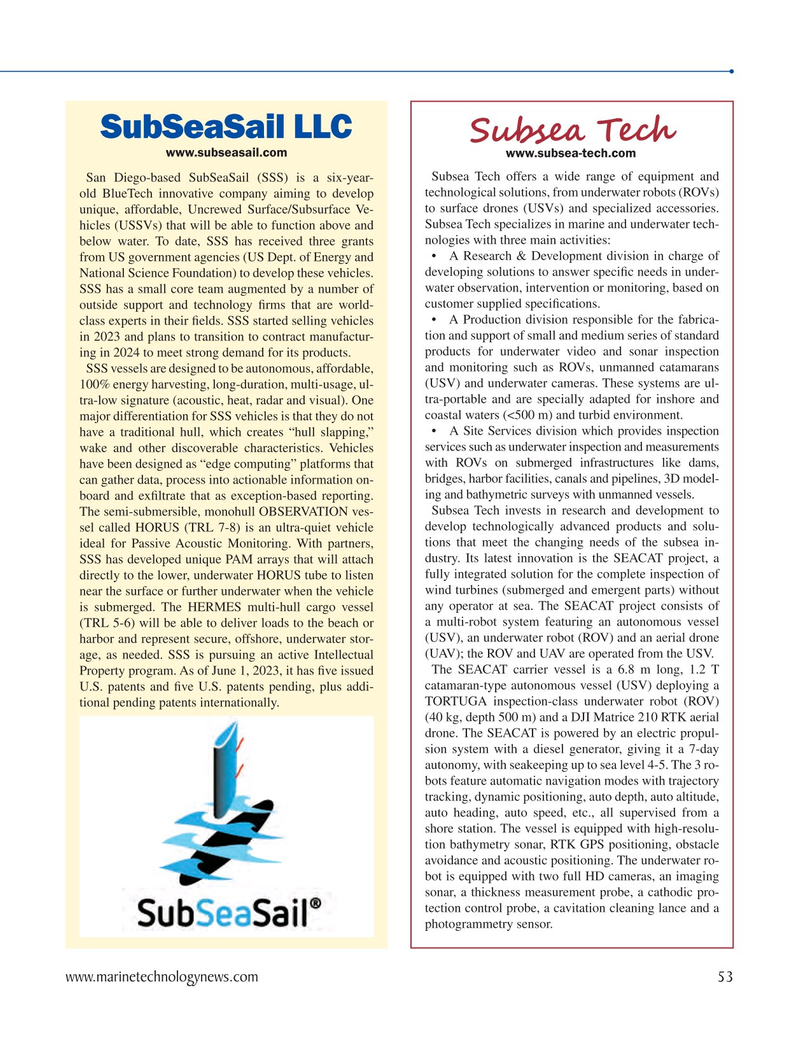
Page 53: of Marine Technology Magazine (September 2023)
Read this page in Pdf, Flash or Html5 edition of September 2023 Marine Technology Magazine
SubSeaSail LLC
Subsea Tech www.subseasail.com www.subsea-tech.com
San Diego-based SubSeaSail (SSS) is a six-year- Subsea Tech offers a wide range of equipment and old BlueTech innovative company aiming to develop technological solutions, from underwater robots (ROVs) unique, affordable, Uncrewed Surface/Subsurface Ve- to surface drones (USVs) and specialized accessories. hicles (USSVs) that will be able to function above and Subsea Tech specializes in marine and underwater tech- below water. To date, SSS has received three grants nologies with three main activities: from US government agencies (US Dept. of Energy and • A Research & Development division in charge of
National Science Foundation) to develop these vehicles. developing solutions to answer speci? c needs in under-
SSS has a small core team augmented by a number of water observation, intervention or monitoring, based on outside support and technology ? rms that are world- customer supplied speci? cations.
class experts in their ? elds. SSS started selling vehicles • A Production division responsible for the fabrica- in 2023 and plans to transition to contract manufactur- tion and support of small and medium series of standard ing in 2024 to meet strong demand for its products. products for underwater video and sonar inspection
SSS vessels are designed to be autonomous, affordable, and monitoring such as ROVs, unmanned catamarans 100% energy harvesting, long-duration, multi-usage, ul- (USV) and underwater cameras. These systems are ul- tra-low signature (acoustic, heat, radar and visual). One tra-portable and are specially adapted for inshore and major differentiation for SSS vehicles is that they do not coastal waters (<500 m) and turbid environment.
have a traditional hull, which creates “hull slapping,” • A Site Services division which provides inspection wake and other discoverable characteristics. Vehicles services such as underwater inspection and measurements have been designed as “edge computing” platforms that with ROVs on submerged infrastructures like dams, can gather data, process into actionable information on- bridges, harbor facilities, canals and pipelines, 3D model- board and ex? ltrate that as exception-based reporting. ing and bathymetric surveys with unmanned vessels.
The semi-submersible, monohull OBSERVATION ves- Subsea Tech invests in research and development to sel called HORUS (TRL 7-8) is an ultra-quiet vehicle develop technologically advanced products and solu- ideal for Passive Acoustic Monitoring. With partners, tions that meet the changing needs of the subsea in-
SSS has developed unique PAM arrays that will attach dustry. Its latest innovation is the SEACAT project, a directly to the lower, underwater HORUS tube to listen fully integrated solution for the complete inspection of near the surface or further underwater when the vehicle wind turbines (submerged and emergent parts) without is submerged. The HERMES multi-hull cargo vessel any operator at sea. The SEACAT project consists of (TRL 5-6) will be able to deliver loads to the beach or a multi-robot system featuring an autonomous vessel harbor and represent secure, offshore, underwater stor- (USV), an underwater robot (ROV) and an aerial drone age, as needed. SSS is pursuing an active Intellectual (UAV); the ROV and UAV are operated from the USV.
Property program. As of June 1, 2023, it has ? ve issued The SEACAT carrier vessel is a 6.8 m long, 1.2 T
U.S. patents and ? ve U.S. patents pending, plus addi- catamaran-type autonomous vessel (USV) deploying a tional pending patents internationally. TORTUGA inspection-class underwater robot (ROV) (40 kg, depth 500 m) and a DJI Matrice 210 RTK aerial drone. The SEACAT is powered by an electric propul- sion system with a diesel generator, giving it a 7-day autonomy, with seakeeping up to sea level 4-5. The 3 ro- bots feature automatic navigation modes with trajectory tracking, dynamic positioning, auto depth, auto altitude, auto heading, auto speed, etc., all supervised from a shore station. The vessel is equipped with high-resolu- tion bathymetry sonar, RTK GPS positioning, obstacle avoidance and acoustic positioning. The underwater ro- bot is equipped with two full HD cameras, an imaging sonar, a thickness measurement probe, a cathodic pro- tection control probe, a cavitation cleaning lance and a photogrammetry sensor.
www.marinetechnologynews.com 53
MTR #7 (50-65).indd 53 10/3/2023 9:16:44 AM

 52
52

 54
54
